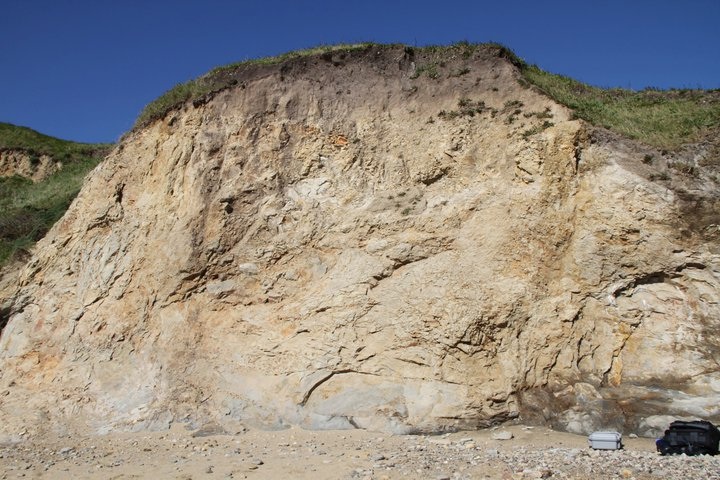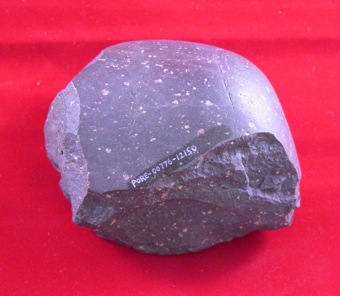Higher tides and increased erosion will wipe out archaeological sites
Hear the radio version of this story from KQED’s The California Report.

On a sunny day earlier this summer at Point Reyes National Seashore, I scrambled behind Mike Newland as he clambered across gullies and bushwhacked through thigh-high lupine. Once we got to the spot he was aiming for, on the edge of a sandy beach-side cliff, he stopped and started to pick through shells and stones.
“You can see, we’ve got sort of a handful of little guys here, popping out of the ground,” he noted. “Some of these that we’re going to see, they weren’t here a year ago, when I came here last time.”
Newland, an archaeologist at Sonoma State University and the president of the Society for California Archaeology, was hunting for Native American artifacts, clues about what life was like in coastal California before Europeans arrived. It was easy for him to find them; wind, rain and tides have eroded these cliffs and exposed the ancient trash piles and stone tools.
This site and these cultural resources — some of them a thousand years old or more — might not be around for much longer. These pieces of California’s history are in danger of disappearing as the Pacific Ocean claws at the base of this cliff. Sea level rise is accelerating the problem.
It’s not just that the tides will be higher. The cliffs are so soft, they could recede hundreds of feet back, with just a few feet of sea level rise.
[module align=”right” width=”half” type=”pull-quote”]”How far inland do we have to go away from the cliff to find stable soil? So that literally our ancestors can rest in peace?”[/module]
“You know, this isn’t just gonna be a matter of, the ocean’s going to pop up and cover it up and then we can get back to it later,” Newland said. “These sites are toast. And we’re essentially losing them all at once.”
Nick Tipon, a retired high school teacher and member of the Federated Indians of Graton Rancheria, whose territory includes Point Reyes, said he became aware of the extent of the erosion several years ago.
“In one part of the park, there’s a layer of soil that indicates human habitation in that spot, and sticking out from the side of a cliff was a human skull,” he said. When human remains are disturbed or exhumed, tribal policy is to rebury them as close as possible to where they were found. “So then we thought, ‘How far inland do we have to go away from the cliff to find stable soil? So we don’t have to do this 100 years, 200 years again? So that literally our ancestors can rest in peace?'”
Newland says there is evidence that people have lived in California for at least 11,000 years, and the soft sandstone cliffs on the coast have always been susceptible to erosion. Traditionally, Tipon said, the tribe would have let the ocean take burial sites, since it was a natural process. But now, with two million or so people visiting the park every year, they can’t leave human remains exposed.
Meanwhile, climate change threatens to expose more of them. A tide gauge in the nearby Golden Gate has recorded eight inches of sea level rise in the past century. Scientists project it could rise three feet in the next.

Point Reyes contains more than 120 Coast Miwok settlement sites. (The Federated Indians of Graton Rancheria includes both the Coast Miwok and the Southern Pomo people.) The National Park Service works closely with Native Americans to protect graves and other important objects or sites. And the Park Service supports and conducts climate research and has programs to help mitigate and adapt to changes coming to the parks. But Mark Rudo, a National Park Service archaeologist, said the Park Service isn’t prepared to deal with the scale of the threat that sea level rise presents.
“At the same time that we’re trying to figure out what the impacts are, we’re also trying to identify what we can do about them, so it’s not an easy situation to work in,” he said. It’s a special challenge with archaeological sites. While it may be possible for natural resources, plants and animals, to migrate, Rudo pointed out that cultural resources, like archaeological sites that remain in the ground, can’t be moved, even with help. “We’re stuck,” he said. “We can’t hide or run away from the problem, or adapt to it.”
But the park does have help measuring the extent of the problem. Newland is recruiting archaeologists from all over the state in a volunteer effort to survey sites along the coast in Marin, Monterey, San Diego and Del Norte Counties, and he hopes to continue expanding the project, to study the thousands of sites up and down the California coast.
[module align=”left” width=”half” type=”pull-quote”]”Every place that we’ve launched off to go explore the world through the ocean is now at risk.”[/module]
“We have to be honest. Most of the sites are going to be destroyed,” he said. “But we should at least know what we’re going to lose. That’s my goal.” At Point Reyes alone, Newland has found that 54 of the 160 sites he studies are in danger of being erased in the next century, and most of the others face some level of threat from other climate change impacts.
And he emphasized, this is going to be a problem everywhere.
“We are in the process of losing all of our maritime sites as a species. Every place that we’ve launched off to go explore the world through the ocean is now at risk,” Newland said.
Tipon, who’s a tribal liaison to the parks, said they’ll have to decide what to try to protect on a case-by-case basis, but he’s less concerned about any given object than with people and culture. And that won’t be washed away as easily.
“One of the questions I get asked a lot when I give speeches is, ‘How long have your people been here?’ And I go, ‘Well, you know, the archaeologists say that it’s 3,000 years, 7,000 years, 11,000 years,'” he said. “But the cultural response is: we’ve been here forever. So how long are we going to be around? We will be here forever.”
2 thoughts on “Rising Seas Threaten California’s Coastal Past”
Comments are closed.

While I truly appreciate this item, we also need to understand that Rising Seas Threaten California’s Coastal Future. While it is not the main point of the article, we might wonder why we spend so much time fighting about the future of oyster farming here. The farm will go away and the oysters are threatened by increasing acidification of the ocean. It seems a bit like rearranging the deck chairs on the Titanic.
I agree with Wes’s comment. I think part of the issue here is that these sites, aside from their archaeological value, have spiritual importance to the tribal groups associated with them throughout the state– the loss of these sites is culturally important to modern people. Also, increasingly, archaeologists have focused on how past cultures have adapted, or not, to climate change events. Part of the broader discussion, not brought up here, is how climate change events have changed the nature of shell beds in the past, both by introducing ocean acidification through increased CO2 as well as changing surface water temperatures and, in the inner bay areas, the salinity levels as a function of reduced run off from droughts. Archaeology, and archaeological sites, have important contributions to make to both current policy making, preservation of sacred areas for tribes, and preparations for the big changes ahead.